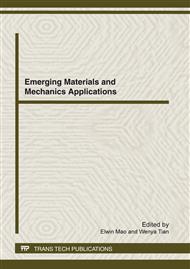[1]
C. Mazzariello: IRC traffic analysis for botnet detection. In: 2008 Fourth International Conference on Information Assurance and Security (IAS), pp.318-323. IEEE, USA (2008).
DOI: 10.1109/ias.2008.58
Google Scholar
[2]
B. McCarty: Botnets: Big and bigger. Security & Privacy, IEEE, 1 (2003) 87-90.
DOI: 10.1109/msecp.2003.1219079
Google Scholar
[3]
Information on http: /www. utdallas. edu.
Google Scholar
[4]
G. P. Schaffer: Worms and viruses and botnets, oh my! Rational responses to emerging Internet threats. Security & Privacy, IEEE, 4 (2006) 52-58.
DOI: 10.1109/msp.2006.83
Google Scholar
[5]
Binkley, J. R. and S. Singh: An algorithm for anomaly-based botnet detection. In: 2nd Workshop on Steps to Reducing Unwanted Traffic on the Internet, pp.43-38, USENIX Association, USA (2006).
Google Scholar
[6]
C. Y. Yin, et al., Research on New Botnet Detection Strategy Based on Information Materials, Advanced Materials Research. 282 (2011) 236-239.
DOI: 10.4028/www.scientific.net/amr.282-283.236
Google Scholar
[7]
C. Hyunsang, et al.: Botnet detection by monitoring group activities in DNS traffic. In: 7th IEEE International Conference on Computer and Information Technology, pp.715-720. IEEE Computer Society, USA (2007).
DOI: 10.1109/cit.2007.90
Google Scholar
[8]
S. Heron, Working the botnet: how dynamic DNS is revitalising the zombie army, Network Security. (2007) 9-11.
DOI: 10.1016/s1353-4858(07)70005-3
Google Scholar
[9]
Lu, W., G. Rammidi, and A.A. Ghorbani, Clustering botnet communication traffic based on n-gram feature selection, Computer Communications. 34 (2011) 502-514.
DOI: 10.1016/j.comcom.2010.04.007
Google Scholar
[10]
W. Lu, et al.: Botcop: An online botnet traffic classifier. In: 7th Annual Communication Networks and Services Research Conference, pp.70-77. Inst. of Elec. and Elec. Eng. Computer Society, Canada (2009).
DOI: 10.1109/cnsr.2009.21
Google Scholar
[11]
L. P. Song, et al., Modeling and analyzing of botnet interactions, Physica A: Statistical Mechanics and its Applications. 390 (2011) 347-358.
DOI: 10.1016/j.physa.2010.10.001
Google Scholar
[12]
H. Tu, et al.: Detecting botnets by analyzing DNS traffic. In: Pacific Asia Workshop on Intelligence and Security Informatics, pp.323-324. Springer, Germany (2007).
DOI: 10.1007/978-3-540-71549-8_40
Google Scholar
[13]
H. R. Zeidanloo, et al.: Botnet detection based on common network behaviors by utilizing Artificial Immune System(AIS). In: 2nd International Conference on Software Technology and Engineering, pp.21-25. IEEE Computer Society, USA (2010).
DOI: 10.1109/icste.2010.5608967
Google Scholar


